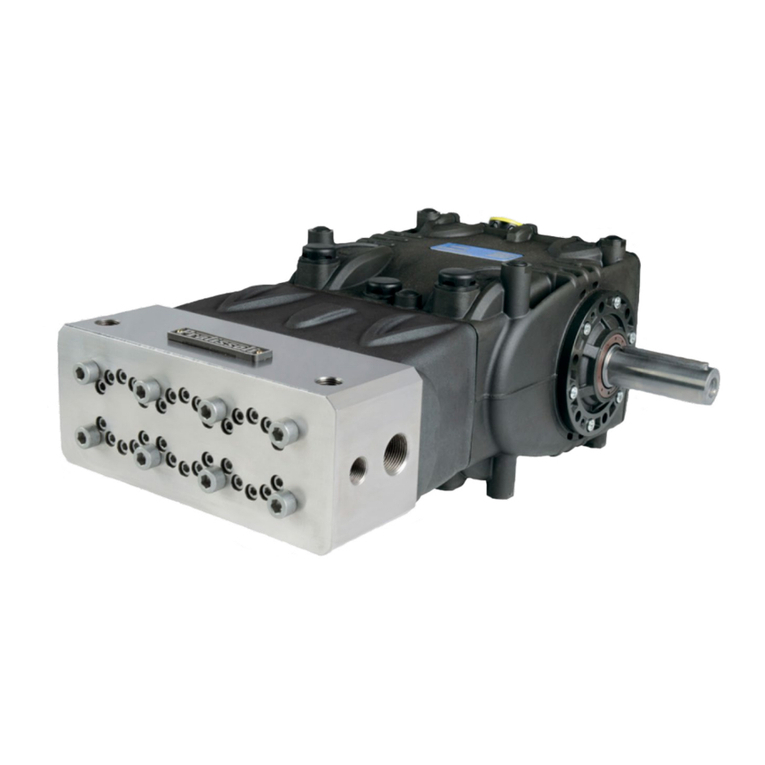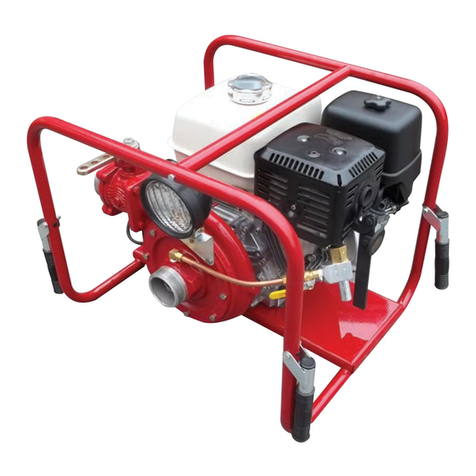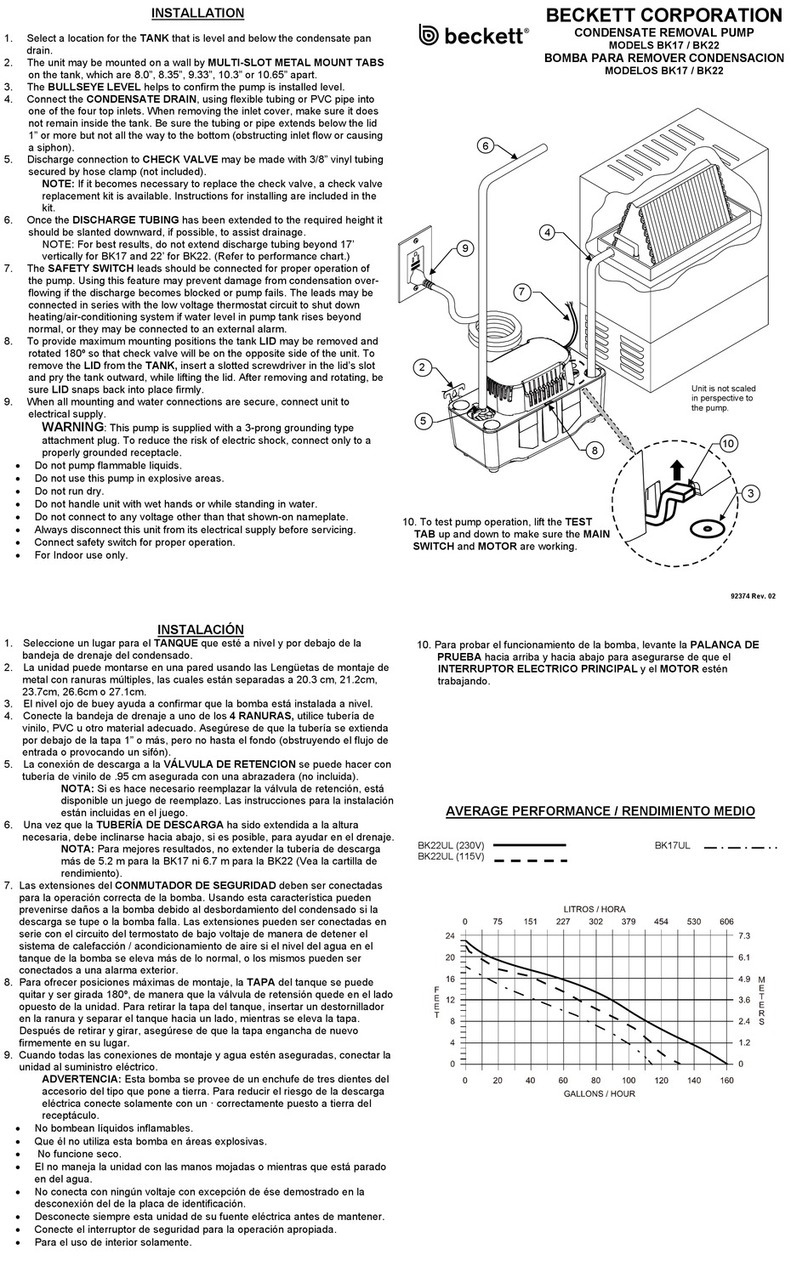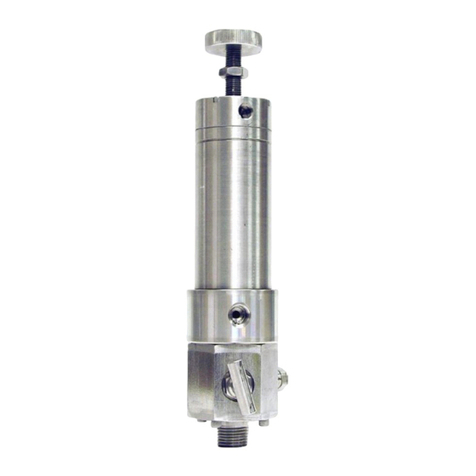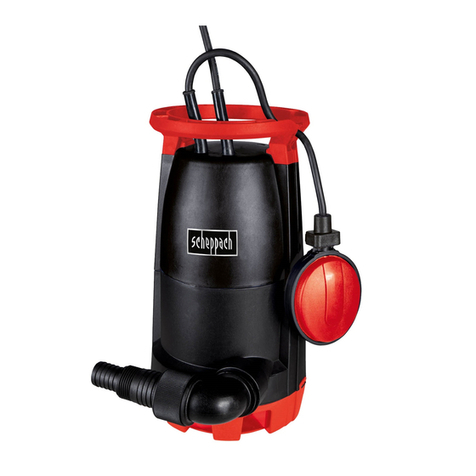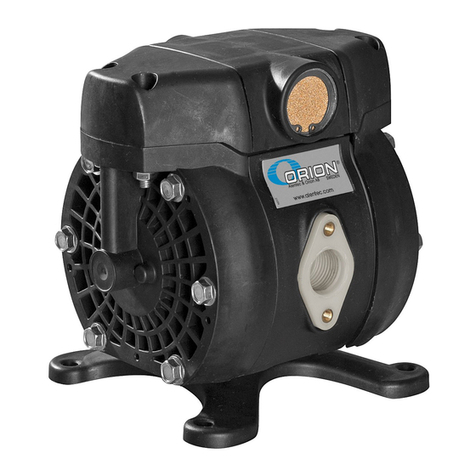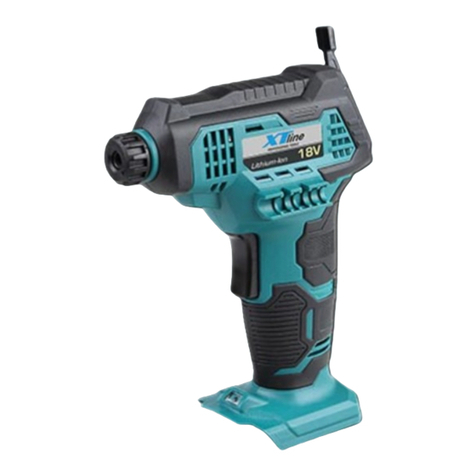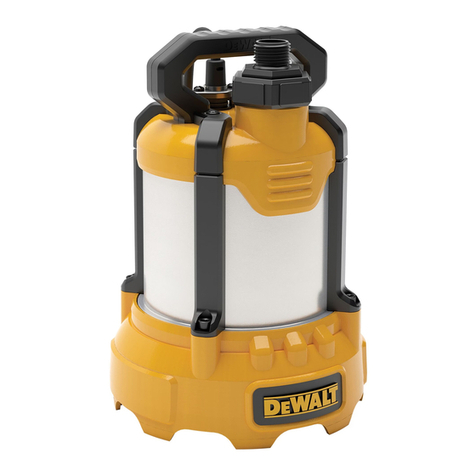General Pump MSS Series User manual

MMSSSS
Owner’s anual
• Ins alla ion
• Use
• Main enance
Note: Photo shows SS pump
with hydraulic drive.

GENERAL PUMP A member of he In erpump Group MSS SERIES
Page 2
1. INTRODUCTION . . . . . . . . . . . . . . . . . . . . . . . . . . . . . . . . . . . . . . . . . . . . . . . . . .Page 3
2. SY BOL DESCRIPTIONS . . . . . . . . . . . . . . . . . . . . . . . . . . . . . . . . . . . . . . . . . .Page 3
3. SAFETY . . . . . . . . . . . . . . . . . . . . . . . . . . . . . . . . . . . . . . . . . . . . . . . . . . . . . . . . .Page 3
3.1 eneral warnings for safe operation . . . . . . . . . . . . . . . . . . . . . . . . . . . . . . . .Page 3
3.2 High pressure unit safety requirements . . . . . . . . . . . . . . . . . . . . . . . . . . . . . .Page 3
3.3 Safety of operation . . . . . . . . . . . . . . . . . . . . . . . . . . . . . . . . . . . . . . . . . . . . . .Page 4
3.4 eneral procedures for high pressure lance/gun operation . . . . . . . . . . . . . . .Page 4
3.5 Safety of maintenance . . . . . . . . . . . . . . . . . . . . . . . . . . . . . . . . . . . . . . . . . . .Page 4
4. PU P IDENTIFICATION . . . . . . . . . . . . . . . . . . . . . . . . . . . . . . . . . . . . . . . . . . . .Page 5
5. TECHNICAL FEATURES . . . . . . . . . . . . . . . . . . . . . . . . . . . . . . . . . . . . . . . . . . . .Page 5
6. DI ENSIONS AND WEIGHT . . . . . . . . . . . . . . . . . . . . . . . . . . . . . . . . . . . . . . . . .Page 6
7. GENERAL INFOR ATION ABOUT SPECIFIC PU P USE . . . . . . . . . . . . . . . . .Page 7
7.1 Water temperature . . . . . . . . . . . . . . . . . . . . . . . . . . . . . . . . . . . . . . . . . . . . . .Page 7
7.2 Maximum flow and pressure ratings . . . . . . . . . . . . . . . . . . . . . . . . . . . . . . . .Page 7
7.3 Lowest operating RPM . . . . . . . . . . . . . . . . . . . . . . . . . . . . . . . . . . . . . . . . . . .Page 7
8. CONNECTION AND PLUGS . . . . . . . . . . . . . . . . . . . . . . . . . . . . . . . . . . . . . . . . .Page 7
9. PU P INSTALLATION . . . . . . . . . . . . . . . . . . . . . . . . . . . . . . . . . . . . . . . . . . . . . .Page 8
9.1 Positioning . . . . . . . . . . . . . . . . . . . . . . . . . . . . . . . . . . . . . . . . . . . . . . . . . . . .Page 8
9.2 Direction of rotation . . . . . . . . . . . . . . . . . . . . . . . . . . . . . . . . . . . . . . . . . . . . .Page 8
9.3 Water connections . . . . . . . . . . . . . . . . . . . . . . . . . . . . . . . . . . . . . . . . . . . . . .Page 8
9.4 Suction line . . . . . . . . . . . . . . . . . . . . . . . . . . . . . . . . . . . . . . . . . . . . . . . . . . . .Page 8
9.5 Filtration . . . . . . . . . . . . . . . . . . . . . . . . . . . . . . . . . . . . . . . . . . . . . . . . . . . . . .Page 9
9.6 Delivery time . . . . . . . . . . . . . . . . . . . . . . . . . . . . . . . . . . . . . . . . . . . . . . . . . . .Page 9
10. START UP AND RUNNING PROCEDURES . . . . . . . . . . . . . . . . . . . . . . . . . . . . .Page 10
10.1 Before start up . . . . . . . . . . . . . . . . . . . . . . . . . . . . . . . . . . . . . . . . . . . . . . . .Page 10
10.2 Starting up . . . . . . . . . . . . . . . . . . . . . . . . . . . . . . . . . . . . . . . . . . . . . . . . . . .Page 10
10.3 Water leakage . . . . . . . . . . . . . . . . . . . . . . . . . . . . . . . . . . . . . . . . . . . . . . . .Page 10
11. AINTENANCE INSTRUCTIONS . . . . . . . . . . . . . . . . . . . . . . . . . . . . . . . . . . . . .Page 11
11.1 Crank mechanism maintenance . . . . . . . . . . . . . . . . . . . . . . . . . . . . . . . . . . .Page 11
11.2 Fluid end maintenance . . . . . . . . . . . . . . . . . . . . . . . . . . . . . . . . . . . . . . . . . .Page 11
11.3 Pumping unit maintenance . . . . . . . . . . . . . . . . . . . . . . . . . . . . . . . . . . . . . . .Page 13
12. SCREW CALIBRATION . . . . . . . . . . . . . . . . . . . . . . . . . . . . . . . . . . . . . . . . . . . . .Page 15
13. AINTENANCE TOOLS . . . . . . . . . . . . . . . . . . . . . . . . . . . . . . . . . . . . . . . . . . . .Page 15
14. PU P STOPPED FOR LONG TI E . . . . . . . . . . . . . . . . . . . . . . . . . . . . . . . . . . .Page 15
15. PRECAUTIONS AGAINST FREEZING . . . . . . . . . . . . . . . . . . . . . . . . . . . . . . . . .Page 16
16. EXPLODED VIEWS AND PARTS . . . . . . . . . . . . . . . . . . . . . . . . . . . . . . . . . . . . .Page 16
17. TROUBLE SHOOTING . . . . . . . . . . . . . . . . . . . . . . . . . . . . . . . . . . . . . . . . . . . . .Page 18

Page 3
GENERAL PUMP A member of he In erpump Group MSS SERIES
1. INTRODUCTION
MSS high pressure water plunger pumps have been
designed for long life industrial duties and provided they
are correctly installed and maintained will give long
trouble-free operation. Read and understand this
manual before using your pump; it contains the
necessary information for the correct installation, use and
maintenance as well as some practical suggestion for
trouble shooting.
Upon receipt of your pump, inspect for overall good
condition and that no items are missing. Any missing
item or damage should be reported before installing
and starting the pump.
3. SAFETY
3.1 General warnings for safe operation
The misuse of a high pressure water unit and the non-
observance of the pump installation and maintenance
instructions may cause serious damages and/or injuries
to people or properties or both.
Any Manufacturer/Operator requested to assemble/use
a high pressure water unit should be competent to do so,
should have the necessary knowledge on every high
pressure component installed in the unit and on the
precautions to be taken in order to guarantee the largest
safety margins during operation. No precaution, so far
as is reasonably practical, should be left out in the
interest of safety, both from the Manufacturer and the
Operator.
3.2 High pressure unit safety requirements
1. A safety valve should be installed in any delivery line
and should be sized to discharge or by-pass the
entire pump flow rate
2. High pressure unit components, with particular regard
for those units working outside, should be adequately
protected against rain, frost and heat.
3. Electric components and wiring should be provided
with an adequate degree of protection, able to protect
them against spray coming from any direction. They
should also be suitable for working in a wet
environment.
4. High pressure hoses and any other accessory under
pressure should be sized in accordance with the
maximum unit working pressure and must always
work within the safety margins indicated by the nose/
accessory Manufacturer.
5. High pressure hose ends should be fastened to a
steady object in order to prevent them from
dangerous sweeping around, should they burst or
come off their end fittings.
6. Proper safety guards should be provided to
adequately cover transmission joints, pulleys, belts or
auxiliary drives.
2. SY BOL DESCRIPTIONS
Warning
Potential Danger
Danger
High Voltage
Danger
Wear protective mask
Danger
Wear goggles
Danger
Wear protective gloves
Danger
Wear protective boots
Read carefully and understand
the manual before operating
the pump

GENERAL PUMP A member of he In erpump Group MSS SERIES
3.3 Safety of operation
The access into the area when a high pressure unit is
working should be strictly prohibited to unauthorized
personnel. The area should be suitably enclosed and its
perimeter, so far as is reasonably practical, cordoned
off and proper warning notices displayed in prominent
positions.
Personnel authorized to enter that area should have been
previously trained to do so and informed of the risks
arising from failures, misuse and any foreseeable
circumstance which may occur during operation. Before
starting the pump unit and bringing it up to pressure the
Operator is requested to carry out the following checks:
1. Make sure that a correct water supply to the pump
is provided.
2. Make sure that water inlet filters are properly clean.
3. Eelectrical components and wiring, with special
emphasis on connections, junction boxes, switches
and supply cables should be free from external
damage (i.e. exposed and broken wires) and
adequately protected against water.
4. High pressure hose should not show apparent
external wear and the fittings at both ends should be
free from signs of erosion or corrosion.
5. Make sure that all fluids (lubricating oil for pump and
engine, cooling water, hydraulic fluids) are at proper
levels and in good condition.
6. Make sure the safety guards are in good condition.
The work should stop immediately and the pressure must
be released in the event that leakage becomes apparent
or if any person becomes aware of an change in condition
or any hazard existing or being introduced. Any failure
must be promptly reported and then checked personnel.
90 dB(A) suitable ear protection is advised.
NOTE: it must be emp asized t at w ereas protective
clot ing provides adequate protection against spray and
flying particles, it does not constitute complete protection
protection against t e direct impact of t e water jet.
Additional protections in t e form of suitable metal s ields
or barriers may be necessary for certain jetting operation.
3. In most jetting operations it is an accepted practice
to employ a team of Operators consisting of two
members at least, in order to provide mutual
assistance in case of need and to rotate their duties
in case of long and heavy work. While the first
Operator holds the gun, the second Operator attends
the pump unit, keeping close watch on the first
Operator for signs of difficulty or fatigue, and
watching the surrounding area for intrusion by other
persons or unsafe situations. If required, he will shut
off the pressure unit until it is safe to continue.
4. The area in which the work is to proceed should be
clear of loose items and debris to prevent
tripping and slipping hazards.
5. The water jet should be directed only and always
against the workpiece even during preliminary
operating tests prior to starting work.
6. Where applicable, proper side shields should be
suitable placed to safeguard personnel and
equipment against contact with grit or particles
removed by the water jet.
7. On no account must the Operator be distracted
during operation until the jet has been stopped.
Personnel having reason to enter the water jetting
area should wait until the jet is stopped and his
presence known.
8. Each team member must always be aware of the
actions and intentions of other team members in order
to prevent any dangerous misunderstanding occurring
during jetting operation.
9. The pump unit should not be started and brought up
to pressure unless each team member is in his
designated position, the nozzle directed to the
workpiece and the lance or gun securely held.
3.5 Safety of maintenance
Apart from the working pressure regulation no attempt
should be made to adjust any nut, hose, fitting, etc., while
that part of the system is under pressure. The pump
should be stopped and any pressure in the line released
prior to making any adjustments.
1. The high pressure water unit should be maintained in
accordance with the Manufacturer’s instructions.
2. The unit should be maintained only by competent
personnel
3. Service and maintenance should be carried out with
proper tools in order to prevent any damage on high
pressure connections and fittings.
4. Use of other than original spar parts is strictly
forbidden.
3.4 General procedures for high pressure gun/lance
operation
1. The Operator should take reasonable care for the
safety of himself and of other persons who may be
affected by his acts or omission at work. His actions
should always be governed by his good sense and
responsibility.
2. The Operator should wear suitable waterproof
protective clothing, having regard to the type of work
being undertaken. The clothing set should include
adequate hand protection, suitable boots able to
ensure proper grip on wet floors, helmet provided with
full face shield, waterproof garment providing full
cover to the Operator, including his arms.
As most water jets produce noise levels in excess of
Page 4

GENERAL PUMP A member of he In erpump Group MSS SERIES
Page 5
4. PU P IDENTIFICATION
Each pump is fitted with a rating plate (see Fig. 1)
containing the following information:
2. pump model and version
3. serial number
4. max RPM
5. max operating pressure (bar)
6. oil capacity (ltr) and oil specification
7. gear box ratio
8. max flow rate (l/min)
Pump model, pump version and serial number should
be specified when ordering spare parts. Should the pump
be modified (i.e by changing the original version) than
any change should be mentioned on the rating plate for
future reference.
5. TECHNICAL FEATURES
ODEL RP
FLOW RATE PRESSURE POWER
GP l/min PSI Bar Hp kW
SS36 1800/1500 35.9/35.4 136/134 4350 300 107 79.8
SS40 1800/1500 44.4/43.9 168/166 3900 269 117 87.5
SS45 1800/1500 56.3/55.5 213/210 3050 210 116 86.5
SS50 1800/1500 69.5/68.7 263/260 2470 170 116 86.5
SS55 1800/1500 84.0/83.0 318/314 2000 138 115 85.8
6. DI ENSIONS AND WEIGHT

GENERAL PUMP A member of he In erpump Group MSS SERIES
Page 6
6. DI ENSIONS AND WEIGHT - WITH HYDRAULIC DRIVE

GENERAL PUMP A member of he In erpump Group MSS SERIES
Page 7
7. GENERAL INFOR ATION ABOUT PU P
USE
The MSS pump has been designed to pump fresh filtered
water at room temperature. MSZ and MSN special
stainless steel versions are also available for critical fluids.
7.1 Water temperature
Water temperature is critical for the pump life, the higher it
is, the more likely it is to create cavitation, resulting in
premature seal and valve failures.
Below is the temperature chart
and relevant limitations:
<104oFWater is considered to be at room
temperature.
from
104oF
to
140oF
Feed the plunger pump with a centrifugal
pump supplying at least twice the plunger
pump volume at 30 to 45 PSI
reduce pump rated RPM by 30% to 50%
Make sure the crankshaft turns as
indicated by the arrows located neat the
drive shaft projection
>140oFStandard pump not suitable, contact our
Customer service Department
7.2 ax flow and pressure ratings
The performance data indicated in the catalog and on the
rating plate refer to the maximum performance of the
pump. The use of the pump below the rated performances
does not allow the drop in power absorbed to be balanced
by altering the pressure or volume of the pump above its
maximum value.
7.3 Lowest operating RP
The lowest operating speed of the crankshaft for all MSS
pumps (all versions) is 400 RPM.
8. CONNECTIONS AND PLUGS
MSS pumps are provided with (Fig. 3):
1 - 2 inlet ports -IN Ø 2-1/2” NPT Flanged
Suction line connection to any of the two inlet ports
is acceptable, the port not being used should be
sealed with the correct plug.
2 - 2 outlet ports 1-1/4” NPT.
3 - 1 hole DRAIN provided underneath the crankcase
and designed to drain out the water leakage of the
pressure packings. This hole must always be left
open (see paragraph 10.3, Fig 7, page 9).

GENERAL PUMP A member of he In erpump Group MSS SERIES
Page 8
9. PU P INSTALLATION
9.1 Positioning
The pump should be installed flat on a rigid base by
means of the four M12 threaded feet. The base should
be rigid enough to avoid any misalignment or flexing of the
pump/transmission coupling axis due to the torque
involved during operation.
On no account should the pump be installed in such a
way its fluid end rests on the base where the pump is
mounted. The fluid end should be left free and not
subjected to any force. (Fig 4).
9.3 Water connections
In order to isolate the high pressure equipment from the
pump vibrations it is suggested, where applicable, to use
flexible hoses for both suction and delivery lines at least
for the first length. The flexible suction hose must be
rigid enough to prevent it from collapsing during the
suction stroke, when a partial vacuum may occur.
9.4 Suction line
Plunger pumps are not self priming therefore a positive
suction head should always be provided. Information for
the correct suction line:
1. Internal diameter should be at least 3”, in any
point, possibly larger depending on the drop in
pressure due to the length and shape of the line.
2. Should be as straight as possible minimizing changes
in size and direction and positioned in such a way
to allow air pockets and bubbles to escape.
3. Should be perfectly airtight.
4. Should be completely free from 90oelbows, diameter
reductions, counter slopes, “T” connections and
should not be connected to other pipelines.
5. Should positioned in such a way to prevent the pipe
emptying after the pump stops.6. Do not use high
pressure flexible hoses for the suction line.
6 Do not use high pressure flexible hoses for the
suction line.
7. Do not use high pressure hydraulic fittings like 90o
elbows, high pressure adapters, high pressure 3 or
4 way nipples and so on.
8. Do not install any kind of detergent injector along the
suction line.
9. Do not install standing valves, check valves or other
kind of one-way valves.
10. Make sure that the feed tank capacity and the water
minimum level do not give rise to turbulence at the
tank outlet port, which, in turn, might create
cavitation at the pump.
11. Do not connect the by-pass line from the valve directly
to the pump suction line.
12. The water flow from the valve should be directed back
in the tank. Make sure that the by-pass and tank
feeding flows to not give rise to turbulence at the
tank outlet port, which, in turn, might create
cavitation at the pump. Proper baffle plates should
be provided inside the tank.
13. Before connecting the suction line to the pump inlet
port make sure the pipe is perfectly clean inside.
9.2 Direction of rotation
Fig. 5 shows the correct direction of rotation looking at the
pump from the fluid end side. Two arrows stamped on the
crankcase nearby the crankshaft provide the information
as well.

GENERAL PUMP A member of he In erpump Group MSS SERIES
Page 9
9.5 Filtration
All pumps require a suitable filter. The filter should be
installed as close as possible to the pump, should allow
easy inspection and have the following characteristics:
1. The filter capacity should be at least three times the
rated pump volume.
2. Filter port diameters should not be smaller than the
pump inlet ports.
3. Filtration degree in between 50 and 80 mesh (360
to 200 microns.
I PORTANT NOTE: In order to properly safeguard the
pump it is very important to plan cleaning of the filter
with a frequency depending on the water quality,
filtration degree and number of hours of each
application.
9.6 Delivery line
For a correct delivery line comply with the following
instructions:
1. The first length of delivery hose should be flexible in
order to isolate the pump vibrations from the
rest of the system.
2. Use only high pressure hoses and fittings able to
guarantee the largest possible safety margins in
any working conditions.
3. A suitable relief valve should be installed in the
delivery line.
4. Use glycerine filled pressure gauges, as the most
suitable for pulsating loads.
5. When designing the delivery line, take into proper
account the unavoidable drop in pressure, due to
its length and size.
6. If necessary, the effects of the pump pulsations can be
reduced by installing a proper pulsation
dampener in the pressure line.

GENERAL PUMP A member of he In erpump Group MSS SERIES
Page 10
10. START UP AND RUNNING PROCEDURES
10.1 Before start up
Before start up make sure that the following conditions
have been complied with:
1. Suction line should be connected: the pump must
never run dry.
2. Suction line must be perfectly air-tight.
3. Any ON-OFF valve in between the pump and water
source should be open and make sure the water
gets into the pump freely.
4. Set the pressure line in dump mode in order to let
the air in the pump get out easily thus facilitating
the pump priming.
5. Make sure all suction/delivery line connections are
fully tightened.
6. Joint alignment, belt tightening and PTO shaft
inclination tolerances should remain within the
values indicated by the transmission Manufacturer.
7. Make sure the oil level is correct.
No e: in case t e pump as not run for a long period of
time c eck t e suction and delivery valves for scaling
(see paragrap 11.2).
10.2 Starting up
1. Pump and motor/engine should start offload, set the
regulating valve to zero or set the pressure line in
dump mode by means of proper dumping devices.
2. When starting the pump up for the first time or after
every wiring re-connection check for the proper
direction of rotation.
3. Check that the rotating speed does not exceed the
rated value.
4. Before putting the pump under pressure let it run for
some time until the oil flows freely.
5. Before stopping the pump release the pressure from
the system by operating the dump device or by
releasing the regulating valve and reduce RPM to a
minimum (diesel applications).
No e: in case of feeding by a centrifugal pump, make sure
t at t e plunger pump start only w en t e correct
inlet pressure is provided.
10.3 Water leakage
During operation a small amount of water (a few drops a
minute) is released from the pump fluid end; this leakage
is designed to provide lubrication for the pressure
packings. The leakage is drained out of the pump
through a hole in the lower cover (Fig. 6).
This hole must always be kept open.

GENERAL PUMP A member of he In erpump Group MSS SERIES
Page 11
11. AINTENANCE INSTRUCTIONS
11.1 Crank mechanism maintenance.
Check oil level on a weekly basis by means of the two oil
dipsticks (1, Fig 8) provided with notches for min and max
levels.
If necessary, top up from the oil plug 3, Fig. 8.
Check the oil when cold and change the oil when still
hot (pump still at working temperature.).
In order to drain the oil from the pump remove the
magnetic plug 2, Fig. 8.
At every oil change clean the magnetic plug 2, Fig. 8 and
check the lower cover of Fig. 7 for grease
sediments or deposits.
OIL CHAN ES Hours Qty. Oil
Type
First Change 50 10.57
quarts
ISO
220
Subsequent
Changes 500
BRAND TYPE
ENERAL PUMP SERIES 220
ARAL MOTANOL HP 220
AVIA AVILUB RSL 220
BP ENER OL HL 220
CASTROL ALPHA ZN 220
ESSO NUTO 220
FINA SOLNA 220
IP HYDRUS 220
MOBIL DTE OIL BB
SHELL TELLUS C 220
TEXACO RE OL OIL 220
TOTAL CORTIS 220
Oil should be changed at least once a year.
Recommended oils:
11.2 Fluid end maintenance
The fluid end does not require periodical maintenance.
Service operations are limited to valve inspection
and/or replacement, when necessary. In order to remove
the valves:
Loosen and remove the valve cover screws (1, Fig. 9).
Tighten the two grub screws (1 Fig. 10) of each valve
cover until the complete valve unit moves upward enough
to allow easy extraction.
Valve components of each
valve unit are pressed
together in one single block
and therefore they can be
easily replaced and
installed back in place.
Separating the various
components of the valve
unit is carried out by
means of simple tools as
shown in Fig. 11, 12, 13 on
page 11).

GENERAL PUMP A member of he In erpump Group MSS SERIES
Page 12
Check the valve components for wear and replace where
necessary. Every time valves are inspected, all
o-rings and valve covers should be replaced.
Reassemble the valve units and fit them
back in the fluid end. Valve cover screws
should be tightened with a torque wrench
set for 86.7 ft. lbs.
Should excessive scaling inside the fluid end hinder the
valve extraction open one of the two lateral inlet ports,
remove the three plugs, Fig. 15, insert our special tool
p/n F200000050 (or a corresponding one) and push the
valve unit out as shown in Fig. 15.

GENERAL PUMP A member of he In erpump Group MSS SERIES
Page 13
11.3 Pumping unit maintenance
The only maintenance operation required for the pumping
unit is greasing the pressure packings through the proper
greasers (1, Fig. 16).
Greasing should be carried out at even intervals at
least every 100 hours by means of a hand pump. Stop
greasing when the pump trigger becomes harder to
operate: that means the grease chamber is full. Use
top quality silicone grease (i.e. DANKELL OCILIS 250,
penetration coefficient 290 or a corresponding one).
Periodically check the amount of water drained out
by the pump through the hole provided in the lower
cover (Fig. 6). It clearly shows the pressure packing
state of wear; replace them if water dripping becomes
continuous and not intermittent.
Loosen and remove the plunger screws (1, Fig. 18).
Remove the upper cover by loosening the four screws
(1, Fig. 19).
For inspecting the pumping unit remove the head by
loosening the eight head screws (1, Fig. 17).
Push the plungers forward by rotating the crankshaft,
then introduce our tool p/n F200030050 (or equivalent)
in between the piston guide and the packing support
(1, Fig. 20).

GENERAL PUMP A member of he In erpump Group MSS SERIES
With the tool in place, rotate the crankshaft until the
packing support is pushed out together with plungers and
cylinders (Fig. 21 and Fig. 22).
Repeat the operation for each pumping unit.
Remove the wipers from the plunger guides (1, Fig. 23).
In order to fit the new scraper in place shape it manually
as shown in Fig. 25. VERY I PORTANT! The scraper is
provided with an internal lip which performs the correct
scraping effect only if oriented towards the fluid end. See
window inside Fig. 25. Put the pumping unit components
together and fit them back in the pump crankcase. Tighten
the plunger screws (1, Fig. 18) with a torque
wrench set for 72.3 ft. lbs. rease the pressure packings
through the greasers (2, Fig 23) by means of a hand
pump. Stop greasing when the pump trigger becomes
hard to operate: that means the grease chamber is full.
Put head back in place , with head screws tightened at
180.8 ft. lbs.
Separate the pumping unit components and check them
for wear. Pressure packing replacement is carried out
by hand without need for special tools (Fig. 24). A little
bit of grease helps slide the packings into the packing
support. Pressure Packings and o-rings should always be
replaced at every disassembling of the pumping unit.
Page 14

GENERAL PUMP A member of he In erpump Group MSS SERIES
Page 15
Screw calibration is to be carried out by
means of a torque wrench only:
12. SCREW CALIBRATION
13. AINTENANCE TOOLS
The following tools are designed to
facilitate mounting and dismounting
operations of some pump components:
for disassembling:
-Packing support extractor F200030050
-Main gear (gear box) F200030020
- Valve extractor F200000050
14. PU P STOPPED FOR LONG TI E
Before starting the pump for the very first
time after a long period from the date of
shipment check for the correct oil level,
check the valves as indicated in chapter
11 and then comply with the starting
procedures indicated in chapter 10. When
a long inactivity is scheduled drain the
entire suction and delivery line and then
run the pump dry only for a few seconds
in order to drain out the water collected
inside the fluid end.
15. PRECAUTIONS AGAINST FREEZING
In the risk of freezing the following
precautions should be taken:
- After use drain the entire suction and delivery lines
(filter included) by means of discharging devices,
provided and positioned specifically for this purpose
along the lowest point of the lines.
- Run the pump only for a few seconds in order to
drain the water collected inside the fluid end.
Or when applicable
- Add a recommended amount of anti-freeze into the
water tank and run the pump until the anti-freeze
works all through the system.
If a pump is frozen or appears frozen ON NO ACCOUNT
SHOULD THE PUMP BE OPERATED until t e entire
system as been t awed out.
DESCRIPTION Ft. Lbs. N-m Kgm.
Valve cover
screws 86.7 117.6 12
Head Bolts 180.8 245.1 25
Plunger bolts 72.3 98 10
Connecting Rod
Screws 54.2 73.5 7.5

GENERAL PUMP A member of he In erpump Group MSS SERIES
Page 16
16. EXPLODED VIEW AND PARTS LIST

GENERAL PUMP A member of he In erpump Group MSS SERIES
Page 17
REPAIR KITS
Item MSS36 MSS40 MSS45 MSS50 MSS55
66-68-91-92-96-97-99-100 F1134 F1135 F1136 F1137 F1138
37-74-75-80-81 F1139
2-13-14-17-22-28-32-34-35-37-40-4246-49-54
57-60-62-63-66-68-74-75-80-81-86-91-92
96-97-99-100
F1140 F1141 F1142 F1143 F1144
Item Part # Description Qty.
1 F060100240 ear box housing 1
F060100460 ear box housing, 2200 RPM 1
2 F872047005 Washer Ø 10 8
3 F871125108 Screw M 10 x 40 8
4 F052000100 ear 1500 RPM 1
F052000120 ear 1800 RPM 1
F052000280 ear 2200 RPM 1
5 F030000090 ear retainer flange 1
6 F871125105 Screw M 10 x 25 3
7 F872126004 Retainer pin Ø 12 x 40 2
8 F871125110 Screw M 10 x 50 7
9 F010100100 Hydraulic motor flange 1
10 F871125154 Screw M 10 x 30 8-14-16
11 F871125153 Screw M 10 x 25 3
12 F063100190 ear box flange 1
13 F881010131 O-ring Ø 113.97 x 2.62 1
14 F881080026 Oil seal Ø 55 x 75 x 10 1
15 F811110010 Bearing 1
16 F063100150 ear box cover 1
17 F080600140 ear box gasket 1
18 F872097009 Pinion key 1
F872097013 Pinion key (pinion Ø 48) 1
19 F052000110 Pinion 1500 RPM (Z27) 1
F052000131 Pinion 1800 RPM (Z24) 1
F052000180 Pinion 1500 RPM (Z27) Ø 48 1
F052000210 Pinion 1800 RPM (Z24) Ø 48 1
F052000270 Pinion 2200 RPM (Z22) 1
F052000300 Pinion 2200 RPM (Z22) Ø 48 1
20 F811110002 Bearing 1
21 F812000001 Brass bearing 3
22 F872046006 Washer Ø 12 6
23 F035000070 Connecting rod screw 8
26 F871115152 Screw M 6 x 14 16
27 F040000070 Lower cover 1
28 F080600130 Lower cover gasket 1
29 F060100220 Crankcase 1
30 F034000010 Pin 1
31 F811110016 Bearing 1
32 F881080032 Oil seal Ø 70 x 90 x 10 1
33 F063400640 Bearing cover (direct drive version) 1
34 F881080031 Oil seal 65 x 90 x 10 1
35 F080600110 Bearing cover gasket 2
36 F801057002 Magnetic plug 1/2” 1
37 F872043002 Aluminum washer 1/2” 4
38 F063400540 Back cover 1
39 F871121152 Screw M 8 x 20 6
40 F080600100 Back cover gasket 1
41 F001000010 Oil dipstick 2
42 F872041501 Washer Ø 3/8” 2
43 F872026003 Eyebolt M 16 2
44 F030000030 Eyebolt spacer 2-4
45 F801054027 Filling plug 1” 1
46 F881010116 O-ring Ø 29.82 x 2.62 1
47 F801056002 Venting plug 1/2” 1
48 F040000050 Upper cover 1
49 F080600120 Upper cover gasket 1
50 F872100005 Crankshaft key 1
51 F050000100 Crankshaft 1
52 F811111008 Bearing 1
53 F811920004 Bearing bushing 1
54 F872069012 Washer MB 12 1
55 F872020012 Ring nut KM 12 1
56 F063400580 Bearing cover 1
57 F801077003 reaser M 10 x 1 3
58 F250000020 Connecting rod assembly 3
59 F250001060 Plunger assembly 3
60 F872142015 Retainer pin Ø 5 x 36 3
61 F071000060 Wrist pin Ø 28 3
62 F881081000 Oil seal Ø 32 x 45 x 6.2 Spec. 3
63 F881010127 O-ring Ø 64.77 x 2.62 3
64 F063400560 Oil seal plunger cover 3
65 F205000000 Wiper 3
66 F881012115 O-ring Ø 26.65 x 2.62 3
Item Part # Description Qty.
67 F024200340 Plunger MSS36 3
F024200350 Plunger MSS40 3
F024200360 Plunger MSS45 3
F024200370 Plunger MSS50 3
F024200380 Plunger MSS55 3
68F872040004 Washer Ø 10 Spec. 3
69 F871135516 Screw M 14 x 120 inox MSS36-40-45 3
F871135510 Screw M 14 x 80 inox MSS50-55 3
70F208005040 Valve assembly 3
71 F871245358 Screw M 10 x 25 6
72 F871135153 Screw M 14 x 45 12
73 F063100110 Valve cover 3
74 F881112002 Antiextrusion ring 3
75 F881010219 O-ring Ø 65.09 x 3.53 Spec. 3
76 F021300110 Delivery valve guide 3
77 F090200090 Delivery valve spring 3
78 F082200110 Delivery valve poppet 3
79 F081200130 Delivery valve seat 3
80 F881011166 O-ring Ø 66 x 3 Spec. 3
81 F881011159 O-ring Ø 50 x 3 Spec. 6
82 F021300090 Suction valve guide 3
83 F090200080 Suction valve spring 3
84 F082200010 Suction valne poppet 3
85 F081200120 Suction valve seat 3
86 F872041300 Copper washer Ø 1/4” 8
87 680115 Plug 1/4” 8
88 F871145120 Screw M 18 x 180 8
89 F064100340 Manifold 3
90 F084000010 Plug 1/2” nickel 3
91 F881011052 O-ring Ø 78 x 2 9
92 F881011164 O-ring Ø 62 x 3 Spec. 3
93 F062200220 Cylinder MSS36-40 3
F062200230 Cylinder MSS45 3
F062200240 Cylinder MSS50 3
F062200250 Cylinder MSS55 3
94 F031300020 Spacer ring MSS36-40 3
F031300120 Spacer ring MSS45 3
F031300050 Spacer ring MSS50 3
F031300060 Spacer ring MSS55 3
95 F031200090 Packing ring MSS36 3
F031200100 Packing ring MSS40 3
F031200110 Packing ring MSS45 3
F031200210 Packing ring MSS50 3
F031200220 Packing ring MSS55 3
96 F881020010 Pressure packing MSS36 6
F881020011 Pressure packing MSS40 6
F881020012 Pressure packing MSS45 6
F881020014 Pressure packing MSS50 3
F881020015 Pressure packing MSS55 6
97 F881011161 O-ring Ø 56 x 3 MSS36-40 3
F881011163 O-ring Ø 59.5 x 3 MSS45 3
F881011165 O-ring Ø 65 x 3 MSS50 3
F881011167 O-ring 69.5 x 3 MSS55 3
98 F022300340 Packing support MSS36 3
F022300350 Packing support MSS40 3
F022300360 Packing support MSS45 3
F022300370 Packing support MSS50 3
F022300380 Packing support MSS55 3
99 F881010127 O-ring Ø 64.77 x 2.62 MSS36-40-45-50 3
F881010014 O-ring Ø 66.40 x 1.78 MSS55 3
100 F881061014 Scraper MSS36 3
F881061015 Scraper MSS40 3
F881061017 Scraper MSS45 3
F881061018 Scraper MSS50 3
F881061019 Scraper MSS55 3
102 F052000290 Pinion 1800 RPM (Z24) 1
F052000320 Pinion 1500 RPM (Z27) 1
103 F811110014 Bearing 1
104 F063100210 Hydraulic motor flange 1

GENERAL PUMP A member of he In erpump Group
Page 18
MMSSZZ
MMSSNN
MSZ/MSN SERIES
STAINLESS STEEL

GENERAL PUMP A member of he In erpump Group MSZ/MSN SERIES
STAINLESS STEEL
Page 19
REPAIR KITS
Item MSZ/N36 MSZ/N40 MSZ/N45 MSZ/N50 MSZ/N55
66-68-91-92-96-97-99-100 F1157 F1158 F1159 F1160 F1161
24-74-75-80-81 F1162
2-13-14-17-22-24-28-32-34-35
37-40-42-46-49-54-57-60-62-63-66-68
74-75-80-81-86-91-92-96-97-99-100
F1163 F1164 F1165 F1166 F1167
Item Part # Description Qty.
1 F060100240 ear box housing 1
F060100460 ear box housing 2200 RPM 1
2 F872047005 Washer Ø 10 8
3 F871125108 Screw M 10 x 40 8
4 F052000100 ear 1500 RPM (Z55) 1
F052000120 ear 1800 RPM (Z58) 1
F052000280 ear 2200 RPM (Z87) 1
5 F030000090 ear retainer flange 1
6 F871125105 Screw M 10 x 25 3
7 F872126004 Retainer pin Ø 12 x 40 2
8 F871125709 Screw M 10 x 50 Spec. 7
9 F010100100 Hydraulic motor flange 1
10 F871125606 Screw M 10 x 30 inox 8-14-16
11 F871125605 Screw M 10 x 25 inox 3
12 F063100190 ear box flange 1
13 F881010131 O-ring Ø 113.97 x 2.62 1
14 F881080026 Oil seal Ø 55 x 75 x 10 1
15 F811110010 Bearing 1
16 F063100150 ear box cover 1
17 F080600140 ear box gasket 1
18 F872097009 Pinion key 1
F872097013 Pinion key (pinion Ø 48) 1
19 F052000110 Pinion 1500 RPM (Z27) 1
F052000130 Pinion 1800 RPM (Z24) 1
F052000180 Pinion 1500 RPM (Z27) Ø 48 1
F052000210 Pinion 1800 RPM (Z24) Ø 48 1
F052000270 Pinion 2200 RPM (Z22) 1
F052000300 Pinion 2200 RPM (Z22) Ø 48 1
20 F811110002 Bearing 1
21 F812000001 Brass bearing 3
22 F872046006 Washer Ø 12 6
23 F035000070 Connecting rod screw 8
24 F881110127 Washer Ø 12 inox 3
26 F871115152 Screw M 6 x 14 16
27 F040000070 Lower cover 1
28 F080600130 Lower cover gasket 1
29 F060100220 Crankcase 1
30 F034000010 Pin 1
31 F811110016 Bearing 1
32 F881080032 Oil seal Ø 70 x 90 x 10 1
33 F063400640 Bearing cover (direct drive version) 1
34 F881080031 Oil seal Ø 65 x 90 x 10 1
35 F080600110 Bearing cover gasket 2
36 F801057002 Magnetic plug 1/2” 1
37 680680 Washer Ø 1/2” Nickel 1
38 F801057012 Back cover 1
39 F871121603 Screw M 8 x 20 inox 6
40 F080600100 Back cover gasket 1
41 F001000010 Oil dipstick 2
42 F872041501 Washer Ø 3/8” 2
43 F011000020 Eye bolt M 16 Nickel 2
44 F030000030 Eye bolt spacer 2-4
45 F801054027 Filling plug 1” 1
46 F881010116 O-ring Ø 29.82 x 2.62 1
47 F801056002 Venting plug 1/2” 1
48 F040000050 Upper cover 1
49 F080600120 Upper cover gasket 1
50 F872100005 Crankshaft key 1
51 F050000100 Crankshaft 1
52 F811111008 Bearing 1
53 F811920004 Bearing bushing 1
54 F872069012 Washer MB 12 1
55 F872020012 Ring nut KM 12 1
56 F063400750 Bearing cover 1
57 F801077503 reaser M 10 x 1 inox 3
58 F250000020 Connecting rod assembly 3
59 F250001060 Piston assembly 3
60 F872142015 Retainer pin Ø 5 x 36 3
61 F071000060 Wrist pin Ø 28 3
62 F881081000 Oil seal Ø 32 x 45 x 6.5 Spec. 3
63 F881010127 O-ring Ø 64.77 x 2.62 3
64 F063400560 Oil seal piston cover 3
65 F205000000 Wiper 3
66 F881012115 O-ring Ø 26.65 x 2.62 3
Item Part # Description Qty.
67 F024201070 Plunger MSZ/N36 3
F024201080 Plunger MSZ/N40 3
F024201090 Plunger MSZ/N45 3
F024201100 Plunger MSZ/N50 3
F024201110 Plunger MSZ/N55 3
68F881011050 O-ring Ø 17 x 2 Spec. 3
69 F035200120 Plunger screw 3
70 F208006080 Valve assembly MSZ 3
F208006500 Valve assembly MSN 3
71 F871125601 Screw M 10 x 16 inox 6
72 F035000080 Screw M 14 x 40 inox 12
73 F063200120 Valve cover 3
74 F881112002 Antiextrusion ring 3
75 F881010219 O-ring Ø 65.09 x 3.53 Spec. 3
76 F021200160 Delivery valve guide MSZ/N 3
77 F090200150 Delivery valve spring MSZ 3
F090200090 Delivery valve spring MSN 3
78 F082200160 Delivery valve poppet MSZ 3
F082200110 Delivery valve poppet MSN 3
79 F081200440 Delivery valve seat MSZ 3
F082200110 Delivery valve seat MSN 3
80 F881011166 O-ring Ø 66 x 3 Spec. 3
81 F881011159 O-ring Ø 50 x 3 Spec 6
82 F021200140 Suction valve guide MSC/N 3
83 F090200140 Suction valve spring MSZ 3
F090200080 Suction valve spring MSZ 3
84 F082200150 Suction valve poppet MSZ 3
F082200100 Suction valve poppet MSN 3
85 F081200430 Suction valve seat MSZ 3
F081200120 Suction valve seat MSN 3
86 F881110126 Washer Ø 3/8” inox 8
87 F084200471 Plug 3/8” inox 8
88 F035000110 Screw M 18 x 180 Spec. 8
89 F064200210 Manifold 1
90 F821203128 Plug 1/2” inox 3
91 F881011052 O-ring Ø 78 x 2 9
92 F881011164 O-ring Ø 62 x 3 Spec. 3
93 F062200330 Cylinder MSZ/N36-40 3
F062200340 Cylinder MSZ/N45 3
F062200350 Cylinder MSZ/N50 3
F062200360 Cylinder MSZ/N55 3
94 F031200190 Spacer ring MSZ/N36-40 3
F031200340 Spacer ring MSZ/N45 3
F031200350 Spacer ring MSZ/N50 3
F031200360 Spacer ring MSZ/N55 3
95 F031200140 Packing ring MSZ/N36 3
F031200150 Spacer ring MSZ/N40 3
F031200160 Spacer ring MSZ/N45 3
F031200240 Spacer ring MSZ/N50 3
F031200300 Spacer ring MSZ/N55 3
96 F881020010 Pressure packing MSZ/N36 6
F881020011 Pressure packing MSZ/N40 6
F881020012 Pressure packing MSZ/N45 6
F881020014 Pressure packing MSZ/N50 6
F881020015 Pressure packing MSZ/N55 3
97 F881011161 O-ring Ø 56 x 3 MSZ/N36-40 Spec. 3
F881011163 O-ring Ø 59.5 x 3 MSZ/N45 3
F881011165 O-ring Ø 65 x 3 MSZ/N50 Spec. 3
F881011167 O-ring Ø 69.5 x 3 MSZ/N55 Spec. 3
98 F022300590 Packing support MSZ/N36 3
F022300600 Packing support MSZ/N40 3
F022300610 Packing support MSZ/N45 3
F022300620 Packing support MSZ/N50 3
F022300630 Packing support MSZ/N55 3
99 F881010127 O-ring Ø 64.77 x 2.62 MSZ/N36-40-45-50 3
F881010014 O-ring Ø 66.40 x 1.78 MSZN55 3
100 F881061014 Scraper MSZ/N36 3
F881061015 Scraper MSZ/N40 3
F881061017 Scraper MSZ/N45 3
F881061018 Scraper MSZ/N50 3
F881061019 Scraper MSZ/N55 3
102 F052000290 Pinion 1800 RPM (Z24) 1
F052000320 Pinion 1500 RPM (Z27) 1
103 F811110014 Bearing 1
104 F063100210 Hydraulic motor flange 1

GENERAL PUMP A member of he In erpump Group MSS SERIES
Page 20
17. TROUBLE SHOOTING
THE PUMP DOES NOT PRODUCE ANY
NOISE: the pump is not primed
and is running dry!
- No water in the inlet line
- The valves are blocked
- The pressure line is closed and does
not allow the air to get out the fluid
end.
THE PUMP KNOCKS:
- Air suction.
- Insufficient feeding:
- bends, elbows and fittings along the
suction line throttle the amount of
water which passed through.
- too small inlet filter.
- dirty inlet filter.
- the feeding pump, where provided is
not of the suitable type or provides
insufficient pressure or volume.
- The pump is not primed due to
insufficient feeding or the delivery line
is closed during start up.
- The pump is not primed because some
valves are stuck (i.e pump inactivity
for long time).
- Jammed or worn out valves.
- Worn out pressure packings.
- The pressure regulating valve does not
work properly.
- Clearance in the drive system.
- RPM are higher than rated.
THE PUMP DOES NOT DELIVER THE
RATED VOLUME:
- Insufficient feeding (due to the cause
listed above).
- RPM are less than rated.
- Excessive amount of water by-passed
by the pressure regulating valve.
- Worn out valves
- Excessive leakage from pressure
packings
INSUFFICIENT PUMP PRESSURE:
- The nozzle is (or has become) too large.
- RPM are less than rated
- Excessive leakage from pressure
packings
- Excessive amount of water by-passed
by the pressure regulating valve or
faulty valve operation.
- Worn out valves.
EXCESSIVE WATER LEAKA E FROM
THE PUMP:
- Pressure packing are excessively worn
out (due to normal wear or excessive
cavitation).
- Worn out plungers
OVERHEATED PUMP:
- The direction of rotation is not correct.
- Pump is overloaded (pressure or RPM
over the rated values).
- The oil level is too low or the oil is not of
a suitable type or fully used
- Water in the oil
- Excessive belt tension or incorrect
alignment of the joint (where provided).
- Excessive inclination of the pump
during operation.
PIPE VIBRATIONS OR KNOCKIN :
- Air suction.
- The pressure regulating valve does not
work properly.
- The by-pass line is undersized.
- Jammed up valves.
- Drive transmission motion is irregular.
This manual suits for next models
5
Table of contents
Other General Pump Water Pump manuals

General Pump
General Pump EP1506G8 User manual
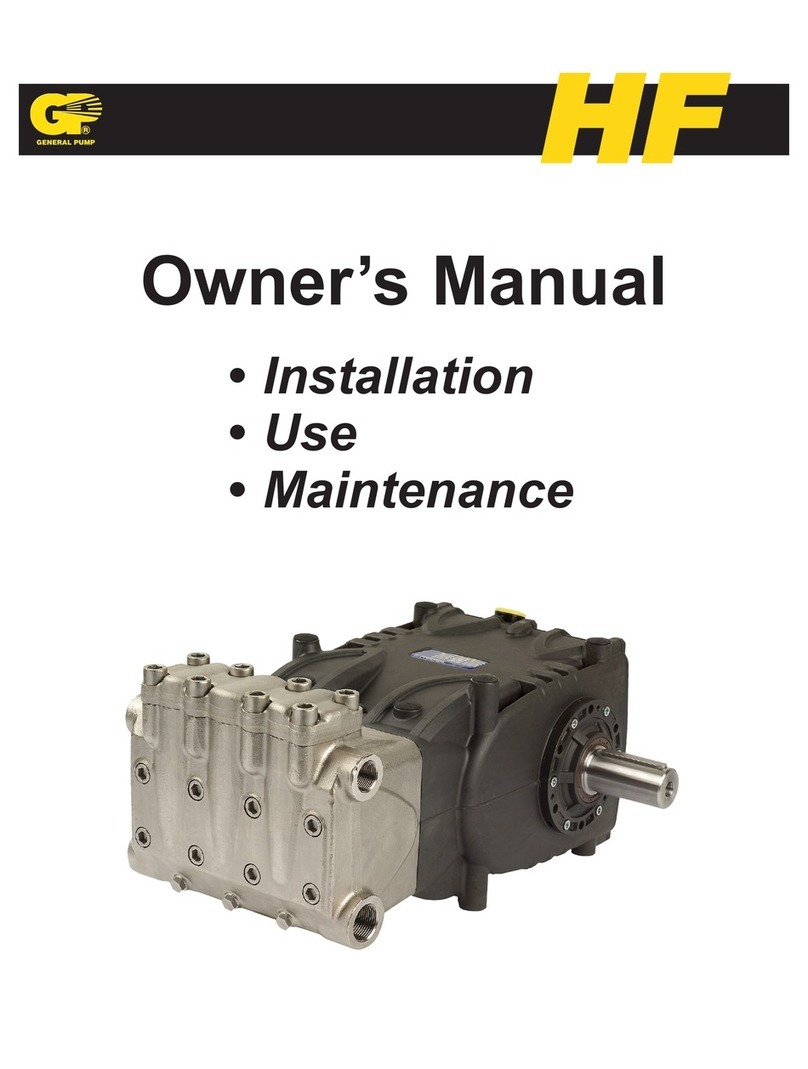
General Pump
General Pump HF18A User manual
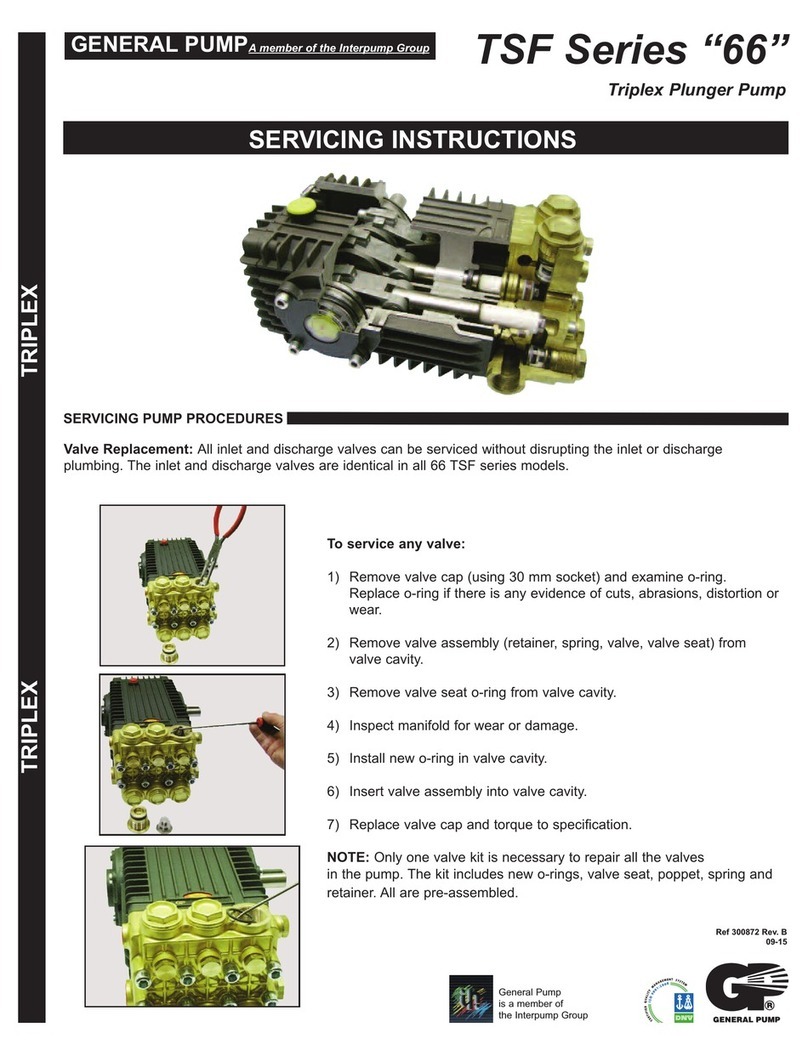
General Pump
General Pump TSF Series 66 User guide
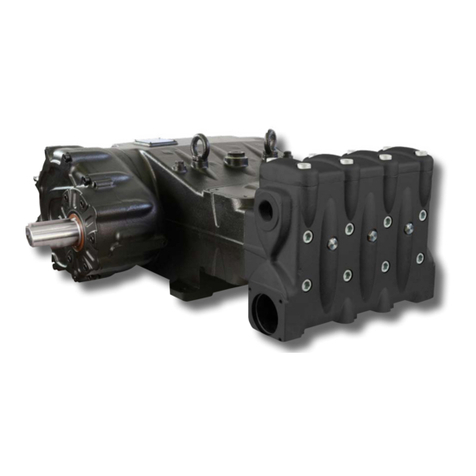
General Pump
General Pump MK2 User manual

General Pump
General Pump SMH User manual

General Pump
General Pump KEZ Series Operating instructions
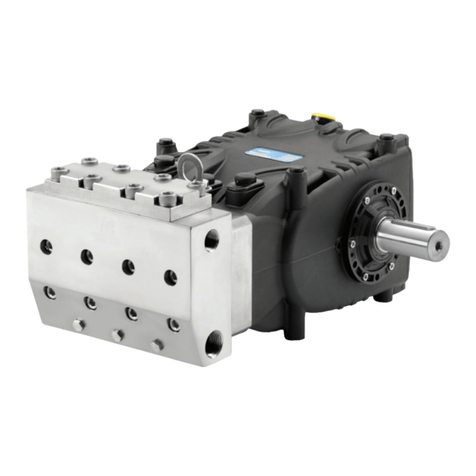
General Pump
General Pump HF Series User manual

General Pump
General Pump HF18 Operating instructions

General Pump
General Pump 47 Series User guide
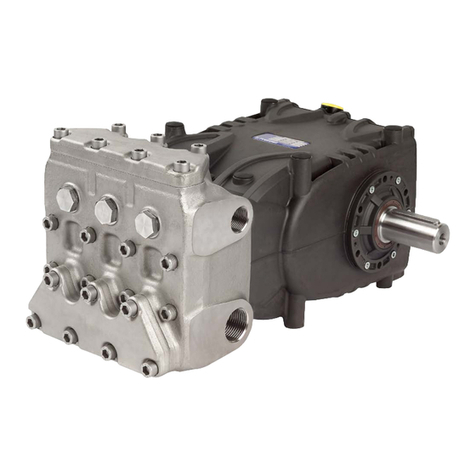
General Pump
General Pump KF Series User manual

